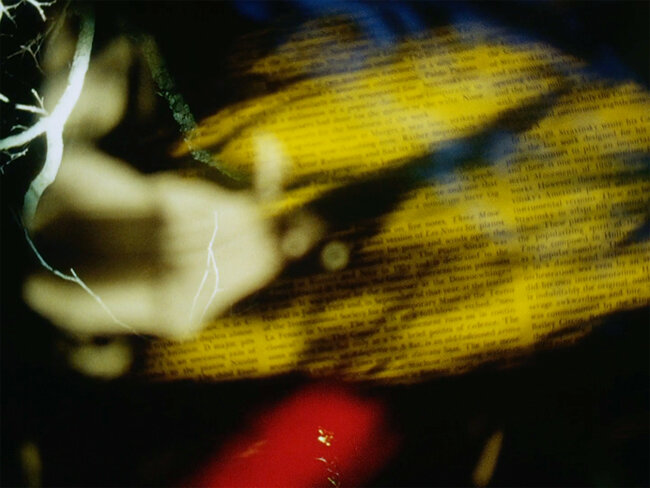머큐리의 언어 Words of Mercury_제롬 힐러 Jerome Hiler



머큐리의 언어 Words of Mercury_제롬 힐러 Jerome Hiler
USA / 2011 / Color / Silent / 25 min / 16mm
9/10(금) 16:00 서울아트시네마 Seoul Art Cinema
Description
<머큐리의 언어>는 16mm 컬러 슬라이드 필름을 보내는 나의 애정 어린 고별사이다. 반 백 년이 넘는 세월 동안 나의 충실한 조력자였던 볼렉스 카메라는 증류할 때 쓰는 그릇이 되어버렸다. 나는 남아있는 엑타크롬 7285 필름에서 최대한 많은 이미지를 뽑아내고 싶었다. 필름의 유화제에 담긴 색상과 이미지가 무척이나 풍부하다 보니 카메라에 찍힌 모든 장면을 합성해서 영화를 만들어야겠다는 결론에 이르렀다. 이 작업을 해 본 사람이라면 이 과정이 얼마나 지난하고 때로는 혹독한 과정인지 알고 있을 것이다. 나도 예전에 몇 번이나 실패한 끝에 두 손을 들었던 적이 있었다. 특히 네 번 이상 겹치도록 찍을 때가 가장 어렵다. 그러나 나는 네 개에서 여섯 개의 목소리로 구성된 중세와 르네상스 시대의 대위법 형식 다성 합창 음악을 평생 들어온 덕에 거기서 영감을 얻었다. 영화가 전개되자 네 겹으로 찍은 구간만 만족스러웠다. 비록 눈으로 보기에 너무 희미하거나 다른 층의 이미지와 겹치는 이미지들도 있어서 네 겹의 이미지가 전부 다 화면에서 보이지 않을 때도 있기는 하지만 말이다.
때로는 여러 층위으로 겹쳐진 이미지의 흐름이 한 층의 이미지로 인해 단절되기도 하는데, 이는 이탈리아 고전 오페라에서 아리아와 레치타티보와의 상관 관계와 같은 효과를 낸다. ( 아트포럼의 P 애덤스 시트니는 이 영화에서 단순한 성가와 다성 합창이 번갈아 진행되는 또 다른 음악적 모델을 읽어냈다.) 그러나 영화 감독이자 실용적인 장인으로서 내게 단일 층위의 이미지는 불안정하게 움직이는 다중 합성 이미지로부터 잠시 쉬어가는 역할을 하는 것으로 보인다. 나는 어지럼증세가 있는데 다중 합성 화면은 놀랍게도 .의도치 않게 내 경험을 모방한 듯한 결과를 낼 때가 있다.
이 영화는 어둠과 황량 세상에서 시작되어 계절 따라 흩어지는 씨앗을 거쳐 종국엔 색감이 넘쳐 질식할 것만 같은 불쾌한 장소 - 죽음을 부르는 장소에 이르는 여정을 그린다. 이 영화의 제목은 죽는 곳을 이야기하는 셰익스피어의 ‘사랑의 헛수고’의 마지막 두 행에서 따왔다.* 나는 아무래도 같은 영화를 계속해서 만들고 또 만드는 듯하다.
WORDS OF MERCURY is my loving farewell to color reversal 16mm film. The Bolex camera, which has served me so well for over fifty years, became a container for a process of distillation. I wanted to extract as much as I could from my remaining rolls of Ektachrome 7285. Film emulsion is so rich with latent colors and images, it was a simple decision to make a film of superimpositions which were all shot in the camera. Anyone who has tried this knows how difficult and sometimes cruel the process can be. In the past, I had renounced it more than a few times in defeat. It's especially hard when shooting four or more layers. But I had my inspiration from a lifetime of musical listening to polyphonic choral music from the middle ages and renaissance - so many pieces in four to six voices. As it developed, only the passages I shot in four layers were satisfying to me, even though all four might not be perceived on the screen since some were sub-visual and some imitated other layers.
The flow of multiple images is sometimes broken with a single layer image, which might have the
effect of the aria - recitative relationship of classical Italian opera. (Although P Adams Sitney, in ArtForum, saw another musical model - that of plain chant alternating with polyphony). But, as a filmmaker, one is simply a practical artisan and, for me, the single-layer images serve simply as relief from the restless movement of the superimpositions. I am subject to vertigo, and to my surprise and without intention, the superimpositions sometimes mimic my episodes.
The film takes a journey from darkness and a bare world through the seasonal spreading of seeds to a place almost choked and repugnant with color - a place that invites death. The final couplet from Shakespeare's LOVE'S LABOR'S LOST speaking of the place of death, supplies me with my title. I seem to make the same film again and again in different ways.
